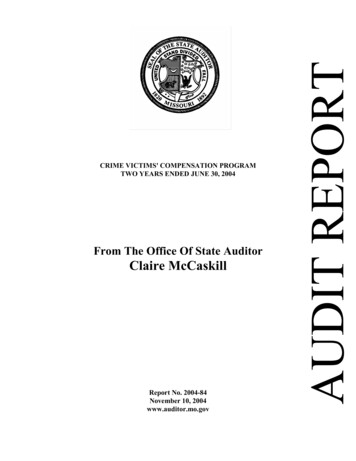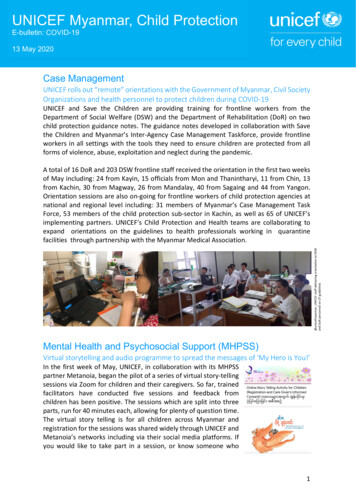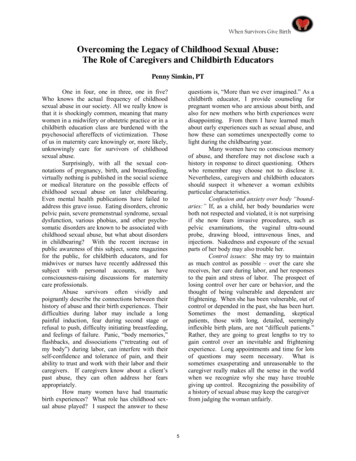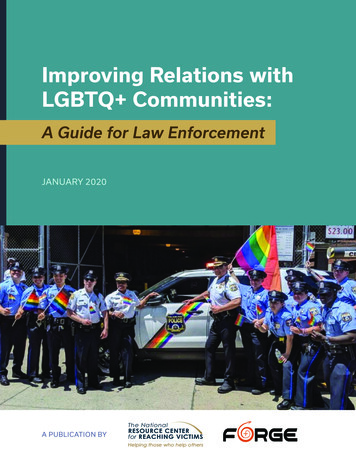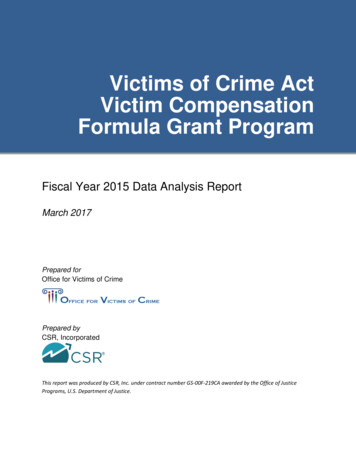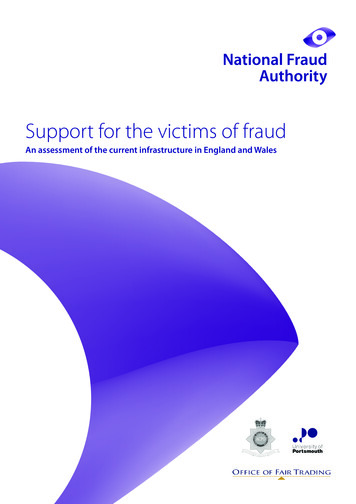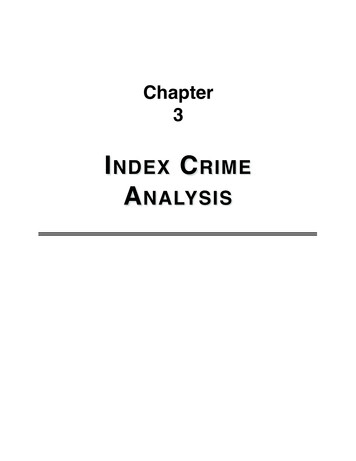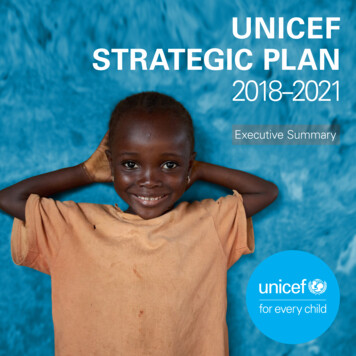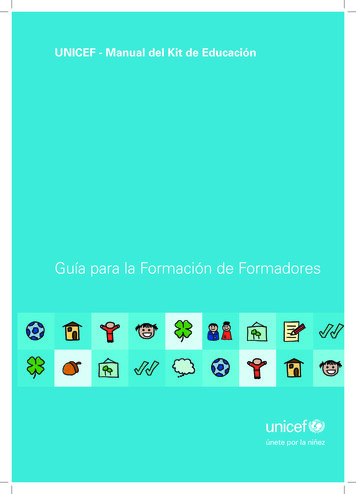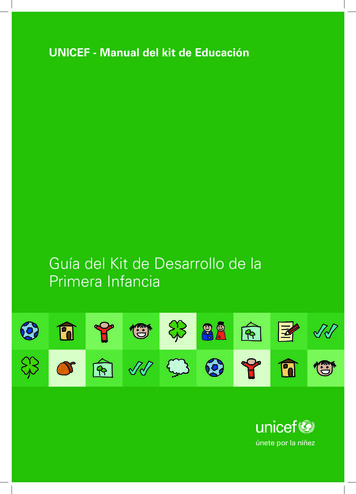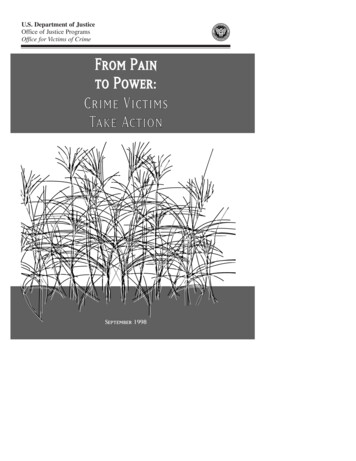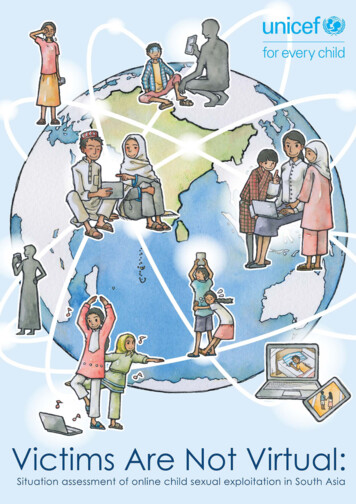
Transcription
The opinions expressed in this work do not necessarily reflect the views of UNICEF.The designations employed and the presentation of the material in this report, including tables, do not imply theexpression of any opinion whatsoever on the part of UNICEF concerning the legal status of any country, territory,city or area or of its authorities, or concerning the delimitation of its frontiers or boundaries.Permission to copy, disseminate or otherwise use information from this report is granted as long as appropriateacknowledgement is given. Suggested citation: UNICEF. Victims Are Not Virtual: Situation assessment of online childsexual exploitation in South Asia, UNICEF, 2016.To the best of our knowledge, the information contained herein is accurate and reliable; however, UNICEF does notassume any liability whatsoever for its accuracy and completeness. United Nations Children’s Fund (UNICEF), Regional Office for South Asia (ROSA), November 2016.Cover illustration and design: Nemm (www.nemmnemm.net/)Design and layout by E.K. Solutions.
VICTIMS ARE NOT VIRTUALSituation assessment ofonline child sexual exploitation in South Asia
AcknowledgementsThis review was prepared by Data & Society Research Institute, and benefited from the expertise of Mark Latonero,Monica Bulger, Bronwyn Wex, Emma Day, Kapil Aryal, Mariya Ali, Keith Hiatt, Patrick Davidson, Alexandra Mateescu,Idil Ali, Mikaela Pitcan, Beth Garrett, Stacy Abder and Janet Haven. Kendra Gregson (UNICEF) guided the project.The specialized knowledge of a distinguished reference group further enhanced this study, and UNICEF thanksthem for their generous insights and careful reviews.Margaret AkulloUNODC, Human Trafficking and Migrant Smuggling Section, Organized Crimeand Illicit Trafficking BranchRamiz BehbudovUNICEF Sri Lanka Country OfficePeta-Gaye BookallUNICEF Pakistan Country OfficeAnjan BoseUNICEF headquarters, New YorkJasmina ByrneUNICEF Office of Research – Innocenti, ItalySongha ChaeUNICEF Sri Lanka Country OfficeSarah ColemanUNICEF Pakistan Country OfficeSusie HargreavesInternet Watch FoundationSarah HicksNational Crime Agency, Government of the United Kingdom of Great Britainand Northern IrelandHemamal JayawardenaUNICEF Sri Lanka Country OfficeWojciech KoprowiczUNICEF Regional Office for South AsiaAniruddha KulkarniUNICEF Bhutan Country OfficeDaniel Laskey-HeardNational Crime Agency, Government of the United Kingdom of Great Britainand Northern IrelandCarla LicciardelloInternational Telecommunication UnionMohamed NaeemUNICEF Maldives Country OfficeRose-Anne PapaveroUNICEF Bangladesh Country OfficeEthel QuayleUniversity of Edinburgh, Clinical & Health Psychology, School of Health inSocial ScienceKate SinnottNational Crime Agency, Government of the United Kingdom of Great Britainand Northern IrelandClara SommarinUNICEF headquarters, New YorkEri Mathers SuzukiUNICEF Regional Office for South AsiaJoachim TheisUNICEF India Country OfficeKarma TseringUNICEF Bhutan Country OfficeShabnaaz ZahereenUNICEF Bangladesh Country Office
ContentsAbbreviations and acronyms. 7Executive summary. 111. Introduction. 151.1 Focus of report. 151.2 Report overview. 161.3 Key research areas. 171.4 Overview of methods. 171.5 Promotion of children’s rights to education, to access information and to freedom of expression. 172. Methodological approach. 212.1 Literature review. 212.2 In-country fieldwork. 212.3 Limitations of research. 212.4 Defining online child sexual exploitation. 222.4.1 Online child sexual exploitation and child abuse. 222.4.2 Online child sexual exploitation . 223. A rights-based review of law and policy related to online child sexual exploitation. 253.1 International child rights law related to online child sexual exploitation. 253.2 Regional initiatives to address online child sexual exploitation. 273.3 Online CSAM and criminal justice. 283.3.1 Model Law on child pornography of the International Centre for Missing & Exploited Children. 293.3.2 The role of INTERPOL. 293.3.3 Global Programme on Cybercrime of the United Nations Office on Drugs and Crime. 303.4 Online facilitation of offline child sexual exploitation and criminal justice . 313.4.1 Online grooming of children. 313.4.2 Online facilitation of child marriage. 313.4.3 Online facilitation of exploitation of children in travel and tourism. 323.5 Corruption of children for sexual purposes, and child protection . 323.6 Sexual extortion of children – child protection and criminalization . 323.7 The child victim’s right to redress – civil and criminal justice, state compensation funds. 343.8 The child’s right to protection: commercial law and industry self-regulation. 353.8.1 Commercial law. 353.8.2 Industry self-regulation. 363.8.3 ITU and UNICEF Guidelines for Industry on Online Child Protection. 373.8.4 The Mobile Alliance against Child Sexual Abuse Content of the Groupe Spécial Mobile Association. 383.8.5 Social media companies – Facebook . . 41
3.8.6 Financial industry. 413.8.7 Private agents. 423.9 Access to justice – the implementation gap. 424. Balancing children’s online protection and participation. 454.1 Opportunities of online engagement . 454.2 Youth negotiation of online risks. 454.3 Youth Internet use in South Asia. 464.4 Risk factors, prevalence and patterns of abuse. 474.5 Types of intervention responses. 494.5.1 Awareness-raising. 494.5.2 Sexuality education. 504.5.3 Reporting hotlines and helplines. 504.5.4 Crisis centres . 524.5.5 Database coordination and data collection . 535. Conclusions and regional recommendations. 555.1 Key recommendations. 555.2 Policy recommendations. 565.3 Intervention recommendations. 56Appendix A. Bangladesh. 59Appendix B. Bhutan . 65Appendix C. Maldives. 71Appendix D. Pakistan. 79Appendix E. Sri Lanka. 87Appendix F. Reference list. 93Appendix G. Important international laws and recognized frameworks for addressingonline child sexual exploitation. 107
List of tablesTable 1. Mobile subscribers, fixed broadband subscribers and Internet users. 16Table 2. Number of stakeholders by country. 18Table 3. Number of stakeholders by sector. 18Table 4. Number of stakeholders by gender. 18Table 5. Number of consultations by type. 18Table 6. Council of Europe benchmarks to address online sexual exploitation. 26Table 7. Signatures to and ratifications of key international instruments related to online child sexualexploitation . 27Table 8. Summary of domestic laws relating to CSAM. 29Table 9. INTERPOL offices in the South Asia study countries . 31Table 10. Sexual extortion of children and corruption of children for sexual purposes under national law. 33Table 11. Groupe Spécial Mobile Association members’ corporate social responsibility initiatives to combatonline child sexual exploitation. 40Table 12. Access to justice in law for child victims of online child sexual exploitation. 44Table 13. Adolescent and under-age-18 population statistics for study countries. 46
Abbreviations and acronymsAPAC-FCACPAsia-Pacific Financial Coalition Against Child PornographyAPRCAct on the Protection of the Rights of Children (Maldives)ARCAdvocating the Rights of Children (Maldives)BBSBhutan Broadcasting ServiceBCMDBhutan Centre for Media and DemocracyBICMABhutan InfoComm and Media AuthorityBIPSBhutan Information and Communications Technology Policy and StrategiesBNLIBhutan National Legal InstituteBNWLABangladesh National Woman Lawyers’ AssociationBTBhutan Telecom LimitedBTRCBangladesh Telecommunication Regulatory CommissionCCAComputer Crimes Act (Sri Lanka)CCPAChild Care and Protection Act (Bhutan)CERTComputer Emergency Response Team (Sri Lanka)CHIChild Helpline InternationalCIDCybercrimes Investigation Department (Sri Lanka)CIDCriminal Investigation Department (Bangladesh)CJPAChildren Judicial Protection Act (Sri Lanka)CRPBChildren’s Rights and Business PrinciplesCRCUnited Nations Convention on the Rights of the ChildCRCCPChild Rights, Child Care and Protection Bill (Maldives)CRINChild Rights International NetworkCSAchild sexual abuse
CSAMchild sexual abuse materialsCSEchild sexual exploitationCSECcommercial sexual exploitation of childrenCSOcivil society organizationCSRcorporate social responsibilityECAPunjab Employment of Children Act (Pakistan)FATAFederal Administered Tribal Areas (Pakistan)FCRFrontier Crimes Regulation (Pakistan)FCSCFamily and Children Service Centre (Maldives)FIAFederal Investigation Agency (Pakistan)FIUFinancial Intelligence Unit (Sri Lanka)GSMAGroupe Spécial Mobile AssociationHRCMHuman Rights Commission of the MaldivesICMECInternational Centre for Missing & Exploited ChildrenICTinformation and communication technologiesICTPIslamabad Capital Territory (Pakistan)ICTAInformation and Communications Technology Association (Sri Lanka)IECinformation, education and communicationILOInternational Labour OrganizationINHOPEInternational Association of Internet HotlinesINTERPOLInternational Crime Police OrganizationISPInternet service providerITInformation technologyITUInternational Telecommunication UnionIWFInternet Watch Foundation
JJUJuvenile Justice Unit (Maldives)KP CPWAKhyber Paktunkhwa Child Protection and Welfare Act (Pakistan)KP CPWCKhyber Paktunkhwa Child Protection and Welfare Commission (Pakistan)MCPDMaldives Child Protection DatabaseMoEMinistry of Education (Bangladesh, Bhutan, Maldives, Sri Lanka)MoICMinistry of Information and Communication (Bhutan)MoITMinistry of Information Technology (Pakistan)MoLGMinistry of Law and Gender (Maldives)MoWCAMinistry of Women and Children Affairs (Bangladesh)MSPVAWMulti-sectoral Programme on Violence Against Women (Bangladesh)NCMECNational Center for Missing & Exploited Children (US)NCPANational Child Protection Authority (Sri Lanka)NCWNational Committee on Women (Sri Lanka)NCWCNational Commission on Women and Children (Bhutan)NPANational Plan of ActionNPACPNational Plan of Action for Child Protection (Bhutan)NR3CNational Response Centre for Cyber Crime (Pakistan)OAGOffice of the Attorney GeneralOCC/OSCCOne-Stop Crisis Centre (Bangladesh, Bhutan)OECDOrganisation for Economic Co-operation and DevelopmentOHCHROffice of the United Nations High Commissioner for Human RightsOPOAObscene Publications Ordinance Act (Sri Lanka)OPSCOptional Protocol to the United Nations Convention on the Rights of the Child on thesale of children, child prostitution and child pornographyPEACEProtection Environment and Children EverywherePEMRAPakistan Electronic Media Regulatory Authority
PHWAProtection Against Harassment at the Workplace Act (Pakistan)PTAPakistan Telecommunication AuthorityRBPRoyal Bhutan PoliceRENEWRespect, Education, Nurture, and Empower Women (Bhutan)SAARCSouth Asian Association for Regional CooperationSAHRSouth Asians for Human RightsSAIEVACSouth Asia Initiative to End Violence Against ChildrenSAPstrategic action planSCPAASindh Child Protection Authority Act (Pakistan)SHESociety for Health Education (Maldives)SOPstandard operating procedureSRHRsexual and reproductive health and rightsSRSGSpecial Representative to the United Nations Secretary General on Violence againstChildrenSVAWCASuppression of Violence Against Women and Children Act (Bangladesh)TITashi Infocom Limited (Bhutan)TRCTelecommunications Regulatory Commission (Sri Lanka)UNDPUnited Nations Development ProgrammeUNFPAUnited Nations Population FundUNHCRUnited Nations High Commissioner for RefugeesUNICEFUnited Nations Children's FundUNODCUnited Nations Office on Drugs and CrimeUPRUniversal Periodical ReviewVPNVirtual Private NetworkVSUVictim Support Unit (Maldives)YDFBhutan Youth Development Fund (Bhutan)
Executive summaryAccess to and use of the Internet introduces youthto a global, borderless network that holds promisefor education, information access and positive socialconnections. Yet it also poses the risk of harmfulencounters. As a growing number of youth go onlinein South Asia, at stake, and the focus of this report, isthe extent to which participation online may exposeyoung users to harmful contacts and interactions.Over a six-month period in 2016, 288 stakeholdersfrom Bangladesh, Bhutan, Maldives, Pakistan and SriLanka contributed their observations and expertiseto a UNICEF-sponsored situation analysis of theonline sexual exploitation of children. Combined withextensive literature and legislative review, the analysisexamined the nature of online child sexual exploitationacross different national contexts and assessedcountry-specific responses.An early finding in stakeholder discussions was thatthe online and offline worlds could not be separated.This merging is not only because individual instancesof abuse can begin offline and be taken online orvice versa, but also, more importantly, because theresponse frameworks that support the victim occurlocally, regardless of whether the crime happenedonline or off. The interventions are the same, andyouth who are abused either offline or online willrequire services from the same providers.Similarly to the rest of the world, prevalence numbersfor online child sexual exploitation in South Asiawere limited. The nature of the crime presentschallenges for prevalence data because most crimesgo unreported, yet existing structures were found notto cooperate with one another, inhibiting data sharingand coordination. Stakeholders interviewed duringfield visits provided insight into potential priorityareas. Many stakeholders reported that abuse andharassment were occurring within social media appsby users with fake accounts. Distribution of photos– some of them doctored – were commonplace andused for extortion or blackmail. International lawenforcement expressed concern about the distributionof child sexual abuse materials (CSAM).While the region currently has no agreed-upondefinition of online child sexual exploitation, for thepurposes of this study, the following definition wasdeveloped from national and international legislativereview and stakeholder interviews:Use of the Internet as a means to exploit childrensexually, which includes cases in which contact childabuse1 and/or exploitation offline is combined withan online component.A finding of this research was the need to distinguishappropriate responses and interventions based on thetype of online child sexual exploitation occurring. Fourbroad categories of online child sexual exploitation(CSE) were identified as currently of most concern tostakeholders in the South Asian countries under study(the third category, corruption of children, was themost discussed concern): child sexual abuse materials (CSAM or childpornography); online facilitation of offline child sexualexploitation, including use of the Internet forchild trafficking, or for child marriage or for theexploitation of children in prostitution; corruption of children, involving adults or otherchildren exposing children to pornography online; sexual extortion of children, which involves onechild voluntarily sharing a nude or sexualizedphoto with another child or an adult, and thenbeing blackmailed as a result.CSAM and online facilitation of offline child sexualexploitation are invariably transnational crimes, whichcall for a strong and proactive transnational lawenforcement response to ensure the perpetrators arecaught and prosecuted, together with provision ofchild protection services to address victims’ needs.However, among the countries in this study, thereappeared to be little proactive law enforcementefforts to search for CSAM online, and instead anyCSAM cases involving child victims from the regionwere alerted to national authorities by InternationalCrime Police Organization (INTERPOL) or foreign lawenforcement agencies.Contact child abuse describes cases in which the abuser comes into physical contact with the child, whereas non-contact child abuse describesacts such as downloading and viewing child pornography, which do not require physical contact but are nevertheless abusive.1
Anecdotal evidence from this study suggests that thethird and fourth categories in the list, corruption ofchildren, and sexual extortion of children, may be lesslikely to be transnational crimes, and instead involveperpetrators in the child’s own country, community,and even peer group. The present study found thatresponses to child victims of these kinds of crimes inthe South Asia region can become complex in casesin which, as well as being exploited, children alsotechnically breach national laws themselves eitherby viewing pornography online or by consenting tosexting.2 There are concerns that such children maybe criminalized for producing and distributing childpornography (of themselves), or for having sex outsideof marriage, instead of being recognized as victims.Online risks were found to fall into two distinctcategories. First, there are CSAM created byperpetrators with a clear predatory sexual interest inchildren, and these materials are exchanged or soldonline. Analysis of stakeholder feedback indicatesthat trends in this kind of sexual harassment andextortion are moving from more static platforms suchas Facebook, to faster moving, more private and moretemporal applications such as WhatsApp, WeChat, andSnapchat. Emerging image-sharing and communicationon platforms that do not store long-term records hasimplications for both the speed of proliferation and forthe removal of images.The kinds of online CSE which involve peer-to-peerabuse and exploitation, and in which the child victimshave some agency, require a different kind of responsethan CSAM and online facilitation of offline childsexual exploitation. In such cases it may be mostimportant to improve children’s understanding ofthe risks involved in online communications, and tobuild their resilience and ability to mitigate such risks.Where the perpetrators involved are the child victim’speers, and children themselves, it is also importantto ensure they receive a strong educational messageregarding the harm caused by such crimes, and abouttheir criminal nature, so that the onus is not simply onthe victim to avoid being exploited, but also on theperpetrators to not victimize their peers.This study found that a majority of interventionsfocus on awareness-raising, for example online safetyguides or training, yet there is a disconnect betweenthe types of abuse youth experience in the regionand the intervention efforts available. It is importantto note that in the case of CSAM, for example,children are groomed and targeted by offenderswith a depth of experience in deception and evadingthe law and are usually part of a larger networkof abusers. Awareness-raising efforts targetedat children and addressing online safety might begenerally helpful, but evidence indicates that a moreeffective intervention would target awareness-raisingtowards parents to help identify symptoms of abuse,characteristics of abusers, and available reportingmechanisms.This study identified an assumption that a technicalfix must exist for problems identified as ‘online’. Inthe case of online child sexual exploitation, theseassumptions are true, but limited. INTERPOL and theInternational Centre for Missing & Exploited Children(ICMEC) lead efforts to identify and take down CSAMimages globally, a technological fix. Yet it is a finding ofthis study that combined with international responsethere is also a need for a local response to attend tothe victims and perpetrators. Local response to onlinechild sexual exploitation relies on the strength of theexisting child protection system, locating treatment ofabuse incidents regardless of where they occur, withinan existing framework. It additionally addresses that asingle child may be victim of multiple forms of abuseand seeking treatment from the same facilities.While the online dimension introduces very seriousissues in terms of expanding the potential reachof perpetrators from local to global, it is a primaryrecommendation of the present study for childprotection systems to focus on existing knowledgeand effective practice of responding to violence andsexual exploitation, and build upon their existingknowledge base and frameworks to address the onlinedimension.There is no single factor that will reduce sexualviolence and abuse. However, a recommendationemerging from this study is that the child protectionsystem must have strong leadership, a focal point thatdrives collaboration within the network and holdsactors responsible for their roles.The local response must be coordinated, with a clearreporting mechanism and pathway for response thatincludes defined responsibilities for units responding,such as health, law enforcement, psychology, familySexting refers to self-generated content involving children, or materials that are produced by a child, of themselves, sometimes within arelationship.2
services and justice, and a referral process thatenables victim recovery and perpetrator sentencing.The system must also engage local Internet serviceproviders (ISPs) and the technology industry inprevention and detection. Most importantly, youthneed to know whom they can trust to turn towhen they have an upsetting experience. Furtherrecommendations can be found in Section 5 of thisreport.
1. IntroductionThis report was commissioned by UNICEF to addressthe online sexual exploitation of children in five studycountries of South Asia. It incorporates informationand analysis from the major phases of the researchproject, including framing and proposal, regionaland international literature review, fieldwork inBangladesh, Bhutan, Maldives, Pakistan and Sri Lanka,and a second literature review based on resourcesobtai
CID Cybercrimes Investigation Department (Sri Lanka) CID Criminal Investigation Department (Bangladesh) CJPA Children Judicial Protection Act (Sri Lanka) CRPB Children's Rights and Business Principles CRC United Nations Convention on the Rights of the Child CRCCP Child Rights, Child Care and Protection Bill (Maldives)
